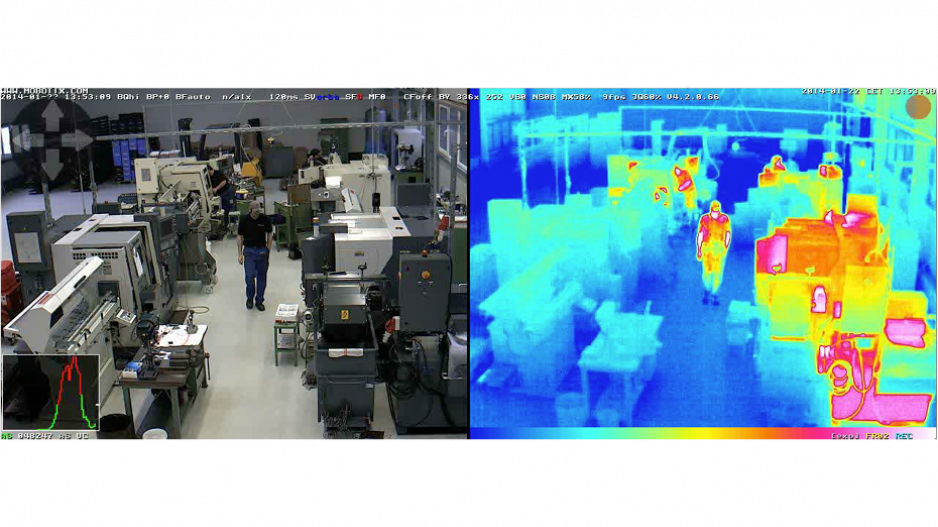Among today’s security solutions, thermal cameras stand out due to their unique ability to operate in almost any environment, offering round-the-clock monitoring even in absolute darkness or extreme weather conditions. They use heat detection to provide clear surveillance where traditional cameras fail and can be used in various situations where precise detection is required. These include everything from perimeter protection and patient monitoring to tracking changes in ambient temperatures, among others.
Thermal cameras are gaining popularity due to their capability to identify potential threats and minimise false alarms while respecting privacy, saving both time and money and ultimately lowering the total cost of ownership (TCO). As these cameras have a long detecting range, only a few of them are required to cover an entire property. Furthermore, the processing capacity in thermal cameras has increased, enabling more advanced analytics.
What is a Thermal Camera?
A thermal imaging camera is a device that employs infrared radiation to create images based on the temperature variations between objects. In contrast to standard cameras, which use visible light to capture images, thermal cameras record the heat emitted by different objects and living beings to provide an image in a variety of colours that correspond to temperature fluctuations.
As thermal cameras are able to visualise temperature changes, they are widely used across a variety of industries. In security, they detect heat emissions that are invisible to the naked eye and improve surveillance, offering a reliable solution irrespective of lighting conditions. These cameras are also used in search and rescue efforts to quickly find persons based on their body heat. Aside from safety applications, thermal imaging cameras are also essential for preventative maintenance as they can identify overheating components in machinery or electrical systems.
How Do Thermal Cameras Work?
Thermal cameras rely on infrared energy or heat radiation, which is emitted by all objects and living beings with temperatures above absolute zero. They contain an infrared detector, which captures and converts this invisible radiation into electrical signals. These signals are then analysed and rendered as a thermogram, or thermal image, which is a colour-coded depiction of the temperature distribution within the scene under observation.
Different colours on the thermogram represent various temperatures. Warmer areas are typically represented in reds or yellows, while cooler areas are shown in blues or purples, depending on the camera’s colour palette. Thermal cameras can see objects and people clearly, even in complete darkness or in adverse weather conditions. Its precision and capability can be measured by the detector’s resolution and thermal sensitivity.
Unlock the Full Potential of Thermal Cameras with Best Practices
Understanding how to effectively use thermal imaging technology can significantly enhance your surveillance capabilities, whether for asset protection, perimeter security, or even something unusual such as wildlife monitoring. Therefore, let us explore the best practices which will allow both installers and end users to get the most out of thermal video surveillance cameras.
1. Proper Installation
Despite being the most obvious step, proper installation is often overlooked and yet is essential to maximise the potential of thermal imaging. As the camera’s utility is heavily influenced by its placement, it should be installed in such a way that it provides a comprehensive view of the area. Therefore, the camera should be set high enough to avoid obstacles while maintaining a clear field of view. Make sure to consider how external factors such as wind and sun glare can affect the thermal reading.
2. Camera Settings Optimisation
Thermal cameras feature a variety of settings that allow you to tailor their performance to the specific requirements of your monitoring situation. These could include sensitivity, contrast, and polarity. It is best to spend some time getting familiar with these options and adapting them to your own needs. For instance, changing the sensitivity level can aid in distinguishing between objects with similar temperatures. Likewise, adjusting the contrast and polarity can be helpful in producing a more detailed image.
3. Regular Maintenance
Although thermal cameras are more resistant to external conditions compared to standard cameras, they still require routine maintenance and calibration. Lens cleaning, software upgrades, and regular thermal calibration are all essential for optimal performance. Moreover, the physical integrity of the camera housing must be checked to ensure that it has not been damaged by environmental factors or vandalism.
4. Security Systems Compatibility
While thermal cameras are quite powerful devices, combining them with other security systems can significantly improve their effectiveness. Pairing thermal imaging with regular security cameras, intrusion detection systems, or even AI-powered analytics software will provide a more comprehensive surveillance solution. This would allow you to leverage each system’s strengths while mitigating their flaws.
5. Analytics Software
Modern thermal cameras often include or may be linked to analytics software, which adds features such as motion detection, automatic tracking, and even specific artificial intelligence (AI) algorithms. While they can significantly enhance the performance of your surveillance system, they should also be properly installed and calibrated. These systems need to be tested and updated regularly to prevent false alerts and ensure smooth functioning.
Are You Looking for Reliable Thermal Cameras for Your Surveillance System?
SPIRALTECH, with over two decades of industry experience, specialises in developing and implementing customised enterprise IP video solutions, including facial recognition, video analytics, and artificial intelligence. We also offer a variety of surveillance solutions, such as thermal cameras and MOBOTIX cameras, for your convenience. Our team of highly skilled and dedicated engineers can assist you with everything from system design and technical support to training. For any of your video surveillance requirements, do not hesitate to reach out to us today!



